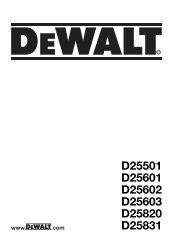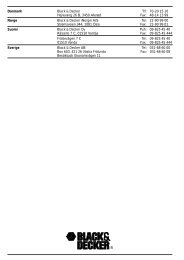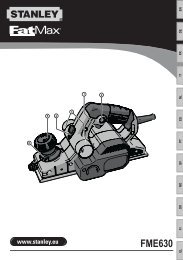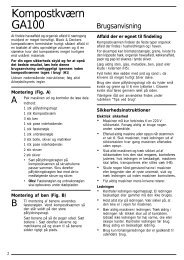DC940 DC945 DC935 DC920 DC925
DC940 DC945 DC935 DC920 DC925
DC940 DC945 DC935 DC920 DC925
Create successful ePaper yourself
Turn your PDF publications into a flip-book with our unique Google optimized e-Paper software.
ENGLISH<br />
Never use a light socket.<br />
Never connect the live (L) or neutral (N)<br />
wires to the earth pin marked E or .<br />
Using an extension cable<br />
An extension cord should not be used unless<br />
absolutely necessary. Use an approved extension<br />
cable suitable for the power input of your charger<br />
(see technical data). The minimum conductor size<br />
is 1 mm 2 ; the maximum length is 30 m.<br />
Assembly and adjustment<br />
● Prior to assembly and adjustment,<br />
always remove the battery pack.<br />
● Always switch off the tool before<br />
inserting or removing the battery pack.<br />
Use only D E WALT battery packs and<br />
chargers.<br />
Battery pack (fig. A & B)<br />
Charging the battery pack (fig. A)<br />
When charging the battery pack for the fi rst time,<br />
or after prolonged storage, it will only accept an<br />
80% charge. After several charge and discharge<br />
cycles, the battery pack will attain full capacity.<br />
Always check the mains prior to charging the<br />
battery pack. If the mains is functioning but the<br />
battery pack does not charge, take your charger<br />
to an authorised D E WALT repair agent. Whilst<br />
charging, the charger and the battery pack may<br />
become warm to touch. This is a normal condition<br />
and does not indicate a problem.<br />
Do not charge the battery pack at<br />
ambient temperatures < 4 °C or > 40 °C.<br />
Recommended charging temperature:<br />
approx. 24 °C.<br />
● To charge the battery pack (10), insert it into the<br />
charger (12) as shown and plug in the charger.<br />
Be sure that the battery pack is fully seated in<br />
the charger. The red charging indicator (13) will<br />
blink.<br />
● When fi nished charging, the charging indicator<br />
will stop blinking and remain on.<br />
The battery pack is now fully charged.<br />
● The battery pack can be removed at any time or<br />
left in the connected charger for a longer period<br />
of time (with a maximum of 14 days).<br />
Inserting and removing the battery pack<br />
● Insert the battery pack into the grip until it clicks<br />
in place.<br />
● To remove the battery pack, press the two<br />
release buttons (11) simultaneously and pull the<br />
pack out of the grip.<br />
Battery cap (fig. B)<br />
A protective cap is supplied to cover the contacts<br />
of a detached battery pack. Without the protective<br />
cap in place, loose metal objects could short circuit<br />
the contacts, causing a fi re hazard and damaging<br />
the battery pack.<br />
● Take off the protective cap (14) before placing<br />
the battery pack (10) in the charger or tool.<br />
● Place the protective cap over the contacts<br />
immediately after removing the battery pack<br />
from the charger or tool.<br />
Automatic refresh<br />
Make sure the protective cap is in place<br />
before storing or carrying a detached<br />
battery pack.<br />
The automatic refresh mode will<br />
equalize or balance the individual<br />
cells in the battery pack at its peak<br />
capacity. Battery packs should be<br />
refreshed overnight after every 10th<br />
charge/discharge cycle or whenever<br />
the pack no longer delivers the same<br />
amount of work.<br />
● To refresh your battery pack, place the battery<br />
in the charger as usual. The red light will blink<br />
continuously indicating that the charge cycle<br />
has started.<br />
● When the charge cycle has completed, the<br />
light will stay on continuously and will no longer<br />
blink. The pack is fully charged and can be<br />
used at this time.<br />
30
















